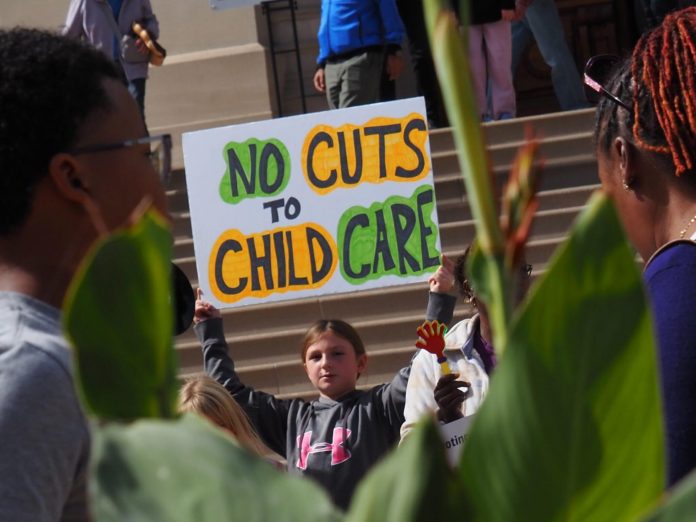|
By Leslie Bonilla Muñiz |
|
Closing sites. Cutting curriculum. Dropping pay. Hoosier child care providers are scrabbling for ways to stay open as Indiana’s freeze on low-income vouchers cramps enrollment and double-digit reimbursement rate cuts eat away at already narrow margins. Providers collectively stand to lose an estimated $3.8 million a week — almost $200 million a year — according to Early Learning Indiana, a prominent child education advocacy group and site operator. “I don’t know where we’re going to be standing at,” said Jonathan Prewitt, who’s operated in-home programs in New Albany since 2011. “… I’m not saying that we’re going to be in business much longer. I’m hoping that we could … because our kids need us.” All of Prewitt’s clients pay with vouchers, which previously covered the cost of attendance at Pit Stop for Kids. Not anymore. “My parents depend on that, and they can’t afford to pay the difference,” he said. But he can’t afford to absorb the losses. Some providers are mobilizing to swap survival strategies, protest the state’s changes or get trained on advocating with lawmakers. “This crisis has created new collaboration,” said Hanan Osman, executive director of the Indiana Association for the Education of Young Children. “… We need to figure out how to resolve this before it’s too late.” Advocates say the cuts hurt more than just an industry. “There is really no second chance for this time of life, to make the kind of change that we can within the architecture of the brain, when children are in responsive and caring environments with learning opportunities around them,” said Maureen Weber, president and CEO of Early Learning Indiana. No exitLow-income Hoosier families can nab vouchers through two child care assistance programs: the federal Child Care and Development Fund and the state-level On My Way Pre-K. About 35,000 children typically participated pre-pandemic, according to the Indiana Family and Social Services Administration. That swelled to nearly 68,000 children in the final months of 2024 — the waning days of former Gov. Eric Holcomb’s administration.  FSSA put the jump in demand down to broadened income eligibility, state capacity-building grants and federal funding when, in December, it implemented the first waitlist for child care vouchers since 2018. “We had, essentially, an extra billion dollars in early care and education through the various rounds of COVID relief funds,” Weber explained. “And those funded a variety of things, but one of them was to fuel that increase in vouchers.” “Given the other decisions that the state might have made with those dollars, serving more children seems like a good one,” she continued. “I think what we didn’t do was have sort of the smoothest exit plan to bring those numbers back down, which is why we have now the really concentrated change that we’re all experiencing.” When Gov. Mike Braun took office in January, he proposed allocating $362 million to child care vouchers — enough to close the waitlist. Lawmakers scrapped that. Instead, they set aside $147 million in “hold harmless” funding for the 2026 fiscal year, which began July 1. It’s enough to renew vouchers at the same income requirements for families already on the program. New enrollees face narrower standards. FSSA is focusing on funding current participants, and “is not issuing new vouchers for 2025,” a spokesperson told the Capital Chronicle. Nearly 30,000 children were languishing on the waitlist in August, according to an agency subsidy dashboard. That’s the latest data available. OMWPK vouchers were curtailed for the current school year: there’s a cap of 2,500 enrollees that can each receive a maximum of $6,800 in funding, narrower eligibility thresholds and other changes. And last month, FSSA announced double-digit reimbursement rate cuts for CCDF vouchers: down 10% for infant and toddler care, 15% for preschoolers and a whopping 35% for school-age children. Braun’s FSSA pinned the blame on the Holcomb administration. “These adjustments address a $225 million funding gap through 2026 created by the prior administration’s unsustainable use of temporary COVID relief funds and ensure continued compliance with federal requirements,” a news release said. The rates went into effect Oct. 5, with the first pay date being Nov. 6. Children with vouchers were at least 25% of clients at almost half the state’s 4,300 providers in a March analysis by Early Learning Indiana. “We’re a really low-margin industry,” Weber said. “If a quarter of your payers are from the public sector, and some big portion of those are going away, there’s vulnerability there,” she added. But she’s most concerned about the 900 “highly dependent” providers with at least 75% of clients using vouchers. Voucher losses are hitting Hoosier providers at an estimated $1.9 million weekly, while reimbursement rate cuts subtract another $1.8 million weekly, according to an Early Learning Indiana dashboard unveiled this month. It breaks down the impacts by county. Cutting backProviders say they’re feeling the impacts — and making adjustments. “The pressures are high,” said the Rev. Jay Height, executive director of Shepherd Community Center in Indianapolis’ Eastside, where about 65% of children pay with vouchers. The organization had about 70 seats, but enrollment has fallen closer to 60. Some have just aged out, but others have lost their vouchers. “There’s no way for them to pay for it,” Height said. “We’re trying to put more emphasis on working with our families to help make sure that they keep their vouchers and don’t let it lapse or miss any deadlines.” Shepherd’s losing roughly $1,400 weekly.  The organization is exploring group purchasing and teacher-sharing; working with a company to examine utility expenses for possible savings; and trying to raise funds. The cuts have prompted a laundry list of changes at Little Duckling Early Learning Schools’ neighboring buildings along 38th Street, where more than 80% of students pay with vouchers. The sites were at 92% capacity this time last year, but are down to 68%, according to Site Director Jacqueline Strong. “We … never had a problem with enrolling. Our biggest issue, if there was an enrollment problem, was just having space,” said Strong, who’s worked at Little Duckling for six years. Some families are using their vouchers at elementary schools, but others are locked out — on the waitlist and unable to cover total costs themselves. Little Duckling has closed four classrooms and moved those students and teachers to the building next door. “With us not getting the new infants that we would’ve normally gotten,” Strong said, three infant rooms with capacity for 24 have dwindled to a single room with capacity for eight. The organization prides itself on its accredited child development and academic programs — even infants and toddlers have curriculums and lesson plans — but those materials have been halved to save money. Little Duckling has nixed free events like field trips and “donuts with dad,” cut back on professional development opportunities, lowered pay for new hires and more. Parents of young children must provide their own diapers. Dozens of providers gathered at Little Duckling this month to share ideas on saving money without dropping their standards. The lower reimbursement rates are “not enough to sustain what is considered a high-quality program,” Strong said.  It’s possible to run a child care center for less money, “but … you’re not able to all of the extra things that a high-quality program would normally do, because you won’t have funds,” she added. Little Duckling has a third site, located in a higher-income area along 82nd Street. A lower share of students use vouchers, so it hasn’t been as impacted, according to Strong. Early Learning Indiana’s Weber predicted conditions will worsen as the reimbursement rates take hold this autumn. Her group runs nine centers in Indianapolis, with about a third of students paying with vouchers. They’re losing $10,000 a week. Still, the 125-year-old organization is “relatively well situated to weather the storm,” Weber acknowledged. She warned others don’t have the operating reserves to survive. Early Learning Indiana has some philanthropic money it uses to support providers across the state, but it’s “a problem at the scale of government, to be candid,” Weber said. “I mean, it’s a multiple hundreds of millions of dollars problem.” Learning advocacySome providers are taking action. Prewitt, of Pit Stop for Kids, is gathering fellow New Albany-area operators to attend FSSA’s next quarterly financial reporting meeting Wednesday, with plans to rally after the child care discussion ends. He worries his parents will have to quit their jobs to take care of their children, or keep working and leave them home alone. Older kids might get into trouble, Prewitt fears, or be deputized into caretakers themselves for younger siblings. “Indiana chose to do this,” he said. “Why they chose to take from our kids instead of taking from one of them higher ups’ pockets or salary makes no sense.” Other providers are gathering, like at Little Duckling. They’re weighing in at listening sessions with the Indiana Association for the Education of Young Children, and they’re getting trained. The association just wrapped up a two-day advocacy and leadership academy in Indianapolis, attended by about 70 early childhood educators, according to Osman. The agenda includes breakout sessions to learn how to write an op-ed, how to approach news outlets or how to speak with lawmakers. “One of the things we (have) learned over the years is that we cannot be angry when we talk to a legislator,” Osman said. “We have to use numbers. We have to be positive. We have to show the collaborative.” The association doesn’t organize protests or endorse political candidates in line with its nonprofit status. Instead, it’s compiling testimonials and preparing members to meet with their representatives about the influence of early child education on kindergarten readiness, ways to lower expenses while maintaining quality and the hunt for sustainable government funding. A Statehouse day is also scheduled for February 5. “We cannot give up the work we have done in 25 years,” Osman said. |




